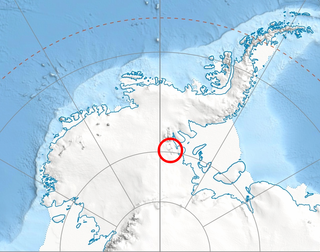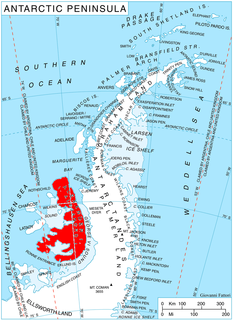
The Amundsen Sea, an arm of the Southern Ocean off Marie Byrd Land in western Antarctica, lies between Cape Flying Fish to the east and Cape Dart on Siple Island to the west. Cape Flying Fish marks the boundary between the Amundsen Sea and the Bellingshausen Sea. West of Cape Dart there is no named marginal sea of the Southern Ocean between the Amundsen and Ross Seas. The Norwegian expedition of 1928–1929 under Captain Nils Larsen named the body of water for the Norwegian polar explorer Roald Amundsen while exploring this area in February 1929.

The Reedy Glacier is a major glacier in Antarctica, over 160 km (100 mi) long and from 10 to 19 km wide, descending from the polar plateau to the Ross Ice Shelf between the Michigan Plateau and Wisconsin Range, and marking the limits of the Queen Maud Mountains on the west and the Horlick Mountains on the east.

The Branscomb Glacier is an Antarctic glacier, 11 nautical miles long, flowing west from the north-west side of Vinson Massif into Nimitz Glacier, in the Sentinel Range of the Ellsworth Mountains. Its upper course receives ice influx from both Goodge Col and Jacobsen Valley, while the tributary Roché Glacier joins Branscomb Glacier just northwest of Príncipe de Asturias Peak.

The Nimitz Glacier is an Antarctic glacier, 40 nautical miles long and 5 nautical miles wide, draining the area about 10 nautical miles west of the Vinson Massif and flowing southeast between the Sentinel Range and Bastien Range to enter Minnesota Glacier, in the central Ellsworth Mountains.
The Ronne Antarctic Research Expedition (RARE) was an expedition from 1947–1948 which researched the area surrounding the head of the Weddell Sea in Antarctica.

Herring Island is an Antarctic rocky island, 3.7 km (2 nmi) long, lying 1.9 km (1 nmi) east of Cloyd Island in the south part of the Windmill Islands. It was first mapped from air photos taken by USN Operation Highjump and Operation Windmill in 1947 and 1948. Named by the US-ACAN for Lt. Charles C. Herring, USN, photographic officer with Operation Windmill parties which obtained air and ground photos of the area in January 1948.

Gibney Reef is an exposed reef lying 0.9 kilometres (0.5 nmi) west of Clark Peninsula, in the Windmill Islands, Antarctica. It was first charted in February 1957 by a party from the USS Glacier. The name was suggested by Lt. Robert C. Newcomb, USN, navigator of the Glacier, after Seaman Joseph Gibney's idea to name it Mussolini Reef was rejected.
Oakley Glacier, is a glacier in the Mountaineer Range that descends east from Mount Casey to merge with the floating tongue from the Icebreaker Glacier at Lady Newnes Bay, in Victoria Land, Antarctica. Mapped by U.S. Geological Survey (USGS) from surveys and U.S. Navy air photos, 1960-64. Named by Advisory Committee on Antarctic Names (US-ACAN) for Lieutenant Commander Donald C. Oakley, U.S. Navy (USN), Protestant chaplain with the winter party at McMurdo Station, 1967.

Union Glacier, is a large, heavily crevassed glacier which receives the flow of several tributaries and drains through the middle of the Heritage Range, Ellsworth Mountains, Antarctica. The glacier drains from the plateau at Edson Hills on the west side of the range and flows east between Pioneer Heights and Enterprise Hills. Union Glacier was mapped by U.S. Geological Survey (USGS) from surveys and U.S. Navy (USN) air photos, 1961-66. The name was applied by Advisory Committee on Antarctic Names (US-ACAN) in association with the name Heritage Range.

Peterson Glacier is a glacier flowing west into Penney Bay opposite Herring Island in the Windmill Islands. Mapped from aerial photographs taken by U.S. Navy (USN) OpHjp, 1946–47, and named for Louie N. Peterson, radio operator and recorder with the U.S. Navy (USN) OpWml parties which established astronomical control stations along Wilhelm II, Knox and Budd Coasts during January–February 1948.

Coulter Glacier is a steeply inclined glacier, 5 nautical miles (9 km) long, flowing south from the Havre Mountains, northern Alexander Island, into Kolokita Cove in Lazarev Bay, Antarctica. The glacier was photographed from the air by the Ronne Antarctic Research Expedition in 1947 and mapped from the photographs by the Falkland Islands Dependencies Survey in 1960. It was named by the Advisory Committee on Antarctic Names for R.W. Coulter, Master of USNS Alatna during U.S. Navy Operation Deepfreeze, 1969.

Cox Glacier is a small glacier immediately east of Rochray Glacier on Thurston Island, flowing south to Abbot Ice Shelf in Peacock Sound. It was delineated from air photos taken by U.S. Navy Squadron VX-6 in January 1960, and named by the Advisory Committee on Antarctic Names for Lieutenant Jerry G. Cox, a helicopter pilot aboard USS Burton Island, who made exploratory flights to Thurston Island in February 1960. Jordan Nunatak stands between Cox and Rochray Glacier.

Hale Glacier is a glacier about 6 nautical miles (11 km) long, located just east of Mount Simpson on Thurston Island, Antarctica, and flowing southwest to the Abbot Ice Shelf in Peacock Sound. It was delineated from air photos taken by U.S. Navy Squadron VX-6 in January 1960, and was named by the Advisory Committee on Antarctic Names (US-ACAN) for Lieutenant Bill J. Hale, U.S. Navy, a helicopter pilot aboard USS Burton Island who made exploratory flights to Thurston Island in February 1960.

Long Glacier is a glacier about 8 nautical miles long in the southeastern part of Thurston Island, Antarctica. It flows south to the Abbot Ice Shelf, 14 nautical miles (26 km) west of Harrison Nunatak. The glacier was mapped by the United States Geological Survey from surveys and U.S. Navy air photos, 1960–66, and was named by the Advisory Committee on Antarctic Names (US-ACAN) for Fred A. Long, Jr., an aviation machinist of U.S. Navy Squadron VX-6, who wintered at Little America V in 1957 and was in Antarctica in the 1960–61 and 1962–63 seasons.

Marck Glacier is a glacier flowing into the southwestern extremity of Cadwalader Inlet on the north side of Thurston Island, Antarctica. It was named by the Advisory Committee on Antarctic Names after Aviation Machinist's Mate George H. Marck, an aircrewman in the Eastern Group of U.S. Navy Operation Highjump, which obtained aerial photographs of Thurston Island and adjacent coastal areas in the summer of 1946–47.

Larsen Bank is a shoal with a least depth of 16 metres (52 ft) in the northern part of Newcomb Bay, Antarctica, located 1 kilometre (0.5 nmi) north of Kilby Island in the Windmill Islands.

Levko Glacier is a glacier flowing from Pallid Crest to the eastern end of Thurston Island, Antarctica. It enters Seraph Bay between Tierney Peninsula and Simpson Bluff. The glacier was named by the Advisory Committee on Antarctic Names after G. Levko, Photographer's Mate in the Eastern Group of U.S. Navy Operation Highjump, which obtained aerial photographs of Thurston Island and adjacent coastal areas, 1946–47.

Clarke Glacier is a 2-mile-wide, 20-mile-long glacier, located on the west coast of Graham Land in Antarctica. It flows west, along the north side of Sickle Mountain and the Baudin Peaksm, to Mikkelsen Bay.
















